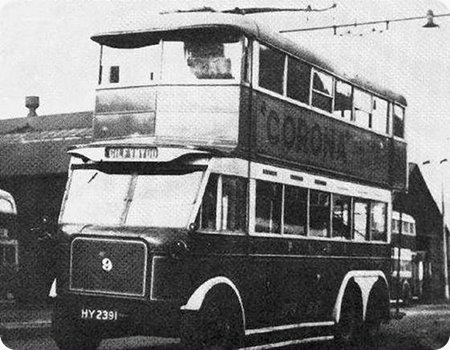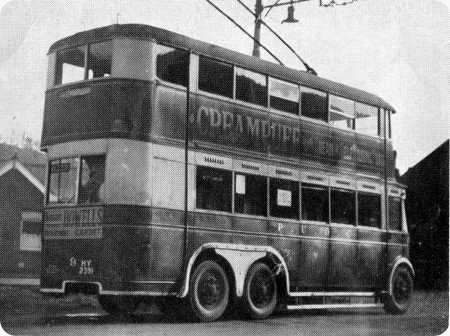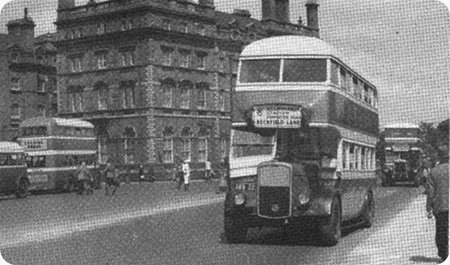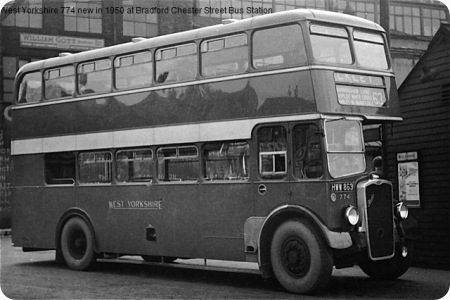
Copyright Roy Marshall
West Yorkshire Road Car Company
1950
Bristol K6B
ECW L27/28R
West Yorkshire 774 (DB 36) Bristol K6B is seen new at Chester Street Bus Station, Bradford on the Ilkley stand in 1950 on the 63 service via Manningham Lane to Shipley, an intermediate place before Ilkley. The service at this time ran every 30 minutes with the alternate bus in the hour running as a 68 service via Canal Road to Shipley and then to Ilkley. Only recently had the 63/68 service been operated by double deckers due to a revision of the route in Ilkley which now avoided a low railway bridge in Ben Rhydding. The Bradford to Ilkley service was previously operated by single decker pre-war Bristol L5Gs and Bristol JO5Gs.
This was a route I used often and loved the challenge to the buses climbing Hollins Hill and also the (A65) road dip under the railway bridge near Burley-in-Wharfedale. This bridge was removed after the line from Burley to Otley closed in March 1965. The road level was then changed so no more excitement at testing the bus suspension.
The Bristol K6B/ECW buses were the workhorses for many BTC fleets during the fifties and sixties and this was certainly the case with West Yorkshire. I can never recall a breakdown and the Bristol K6B was certainly a most reliable type of bus. A lovely feature which I often heard on a still evening at home was the throb across the fields of the Bristol AVW engine caused I think by the fuel governor. Perhaps someone with more expert knowledge of Bristol bus mechanics can explain.
Another interesting feature at Chester Street Bus Station seen on the photograph was the green hut adjacent to the Ilkley stand which served as the Inspectors Office. This hut had also the store racks for the “bible” indicators used on most of the pre-war West Yorkshire buses. This hut was always a fascinating place for a small boy to watch the busy activity of the drivers/conductors collecting or returning these cumbersome indicator boards.
Photograph and Copy contributed by Richard Fieldhouse
A full list of Bristol codes can be seen here.
———
25/05/11 – 16:52
Dare I be precocious enough Richard to say that this excellent piece was written specially for me ?? – a tongue in cheek remark obviously. This is a route known very well to me as a passenger and, later, as a conductor when I worked at WYRCC’s Ilkley Depot in 1960/1. As you rightly say, the Inspectors’ green hut in Chester Street was a constant hive of activity.
Did you know that Chester Street was actually the public thoroughfare right through the centre of the bus station??, although virtually all motorists assumed that it belonged to The Company and so didn’t dare to use it !! Sometime after the "double decking" of the Ilkley services the hourly 68 was discontinued (apart from a few peak hour trips Monday to Friday) and the half hourly service became entirely 63 via Manningham Lane.
There were actually two adjacent railway bridges over the A65 below Menston and, as you say, it was somewhat terrifying for passengers and drivers on the approach, as it seemed certain that the bus roof would be rudely removed – and the sensation was even worse with Samuel Ledgard’s highbridge vehicles.
I can’t honestly remember the intermediate destination blinds being as commendably detailed as shown here – later editions showed only Manningham Lane, Shipley, White Cross. The bottom line in this picture is a little blurred but appears also to say Burley Ben Rhydding. Incidentally the Company seemed to think that Bradford residents would not have heard of Ben Rhydding and so the rule was that on leaving Bradford "ILKLEY" would be shown, and upon reaching the area of local knowledge at Burley the display had to be altered to show "BEN RHYDDING." I’m always blissfully happy to be reminded of those lovely enjoyable days so thank you again.
Chris Youhill
———
26/05/11 – 07:30
Very interesting comments about Bradford. Whilst I have a good knowledge of the present day city centre, I’m afraid I have no memories of how it was. Would I be correct in thinking that Chester Street Bus Station was taken out of use when the interchange opened? Do any traces of it still exist or has it been completely obliterated? I’ve seen many a photograph taken against the background of the white wall and always thought it looked a very evocative place.
Chris Barker
———
27/05/11 – 08:35
I’ve no idea, Chris B, about the present status of Chester Street but I’ll certainly have an "on site" look next time I visit the National Media Museum only a couple of hundred yards (or metres nowadays) away.
Chris Youhill
———
27/05/11 – 08:37
Chester Street closed with the advent of the Interchange. Chester Street is now just a street and is changed totally although some of the buildings on the"West Yorkshire" side still exist
Chris Hough
———
27/05/11 – 09:35
I fear, Chris Y, that you will be sadly disappointed, although not surprised, at the present state of Chester Street. It is now a busy dual-carriageway – part of a typical inner-city gyratory road system. However, some of the background buildings seen on old bus photos are still recognisable, eg. the roof lights of the old Public Baths in Morley Street (now a Wetherspoons).
On the Hebble side, there’s a new building, but the West Yorkshire loading area now seems to be a car park. The much-rebuilt 1960s Mecca Ballroom multi-storey, seen in latter day photos of the bus station, still dominates the background at the western entrance.
Paul Haywood
———
29/05/11 – 07:18
Chris B, as Chris H says, Chester Street bus station was closed following the opening of the Interchange in I think, 1977 – the year of The Queen’s Silver Jubilee. Chris Y’s comment about Chester Street being a public thoroughfare is most interesting, as I remember the roadway very well, but must admit would not have dared to use it for the reason outlined by Chris! The bus station spanned an area between Little Horton Lane (opposite the Silver Blades ice rink) and Morley Street (opposite the top end – or rear – of The Alhambra theatre). It was a place of much interest to the enthusiast with West Yorkshire, Yorkshire Woollen, Yorkshire Traction, Hebble and Samuel Ledgard vehicles using it. (Am I right in thinking that Ribble also used it for coaches linking Lancashire and Yorkshire?) In the mid-sixties Bradford CT added even more variety with its AEC Regent Vs and Daimler CVG6LXs, following an agreement allowing joint operation of the Bradford – Eldwick – Dick Hudson’s service with West Yorkshire. It seemed strange at first seeing a bright blue ‘Corporation’ bus in what otherwise seemed to be a mainly red ‘Company’ bus station, but Bradfordians are not easily fazed and took it all in their stride! As Paul states, Chester Street still exists, but sadly as yet another stretch of dual carriageway.
Brendan Smith
———
31/05/11 – 18:49
This piece was written for me too, Chris. What amazing memories it conjures up! Many a time have I boarded the bus for Ilkley at that very spot against the famous green shed.
I knew Chester Street as a lad, right up to leaving Bradford in 1968, and remember the through street so well, and can count 6 operators who used the facility:-
West Yorkshire, Ledgard, Hebble, Yorkshire Woollen, Yorkshire Traction, and Sheffield (C ?).
West Riding also came into Bradford, but from memory, did not use Chester Street.
I always associate older generation Bristols with Gardner "5"s, but the AVW was extremely characterful from a "music" point of view, and made for an extremely fast bus. I can remember "flying" along on the routes out of Bradford, especially past Shipley, and the HWW batch represented, to me, the pinnacle of ECW post war design. Flush interior sides, tubular seats, and metal framing all came together in these vehicles to produce a quality of vehicle not yet bettered, in my view. Superb buses!
John Whitaker
———
01/06/11 – 07:44
I’m glad there is such affection for the Bristol K (especially the 6B). Many people seem to turn their noses up, calling them boring and bog-standard etc. and I hate to hear it. For sure, you could find them from Lands End (Western National) to Northumberland (United), and Yarmouth (Eastern Counties) to Pwellheli (Crosville)- and a lot of other places and operators in between (take a bow, West Yorkshire). But you will notice that all of the extremities I listed are coastal holiday destinations. For me Bristol K6Bs (and their melodious note in second and third gears, which I could cheerfully listen to for hours) are inextricably associated with happy memories of seaside holidays. (And the sun always shone!)
Stephen Ford
———
01/06/11 – 07:47
I agree fully John with your commendation of the "HWW" DBs, but their super qualities were suddenly eclipsed for we Ilkley folk when 806 – 809 (DBW1 – 4) arrived – 8 feet wide and with classy white steering wheels. Originally having open platforms (returned later to ECW for doors) they seemed quite simply enormous and spacious and they are a batch from my teenage years which I still hold in great affection.
Chris Youhill
———
01/06/11 – 07:50
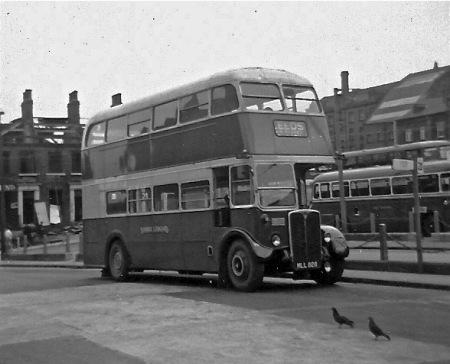
The Chester Street, Bradford thread made me dig out this photo of Ledgard MLL 828 (former RT3518) which clearly shows the through road between the chain fences separating the West Yorkshire stands from "the others". Unlike most of my photos, this one has the date 14 June 1964 written on it, and it shows the buildings on Little Horton Road being demolished to make way for the Silver Blades Ice Rink (owned by Mecca but not a Ballroom as I mistakenly said in my previous thread.)
Paul Haywood
———
01/06/11 – 10:22
I agree about the 806 – 809 batch Chris, but when the "new" excitement wore off, and in quiet contemplation (!) I do not think the S series 4 bay design had quite the same balance as the classic final version of the first post war 5 bay style.
I greeted the first DXs with absolute rapture, but looking back, I do not personally hold them in quite the same esteem as the HWW series. Something to do with my age perhaps!
John Whitaker
———
01/06/11 – 10:22
Stephen, among my many fond memories of the "DB"s one of my favourite recollections couldn’t possibly be further from the seaside !! When I was a conductor at WYRCC Ilkley Depot any of our Lodekkas away for the statutory two weeks overhaul was replaced by a "KDB" from Keighley – one of the batch between KDB 54 -7. One foul Winter evening, with very heavy snow, I left Ilkley with the 5.25 pm to Haworth on service K12 driven by Brian Wadsworth. After we left Addingham to climb to the "whited out" summit at Marchup Cottages the bus began to boil very seriously. This, of course, was long before two way radios and mobile telephones and we felt rather as if we were approaching the North Pole. – "Only one thing for it" said Brian "We’ll have to fill it up with snow." We both set about the task with gusto, while the red hot radiator and engine hissed and tinkled in astonished protest. Once we achieved the necessary level we resumed the journey – to Haworth and back to Ilkley for 8.07pm – without incident. Looking back of course, with the benefit of hindsight, it was a really foolish first aid measure which I imagine could have caused considerable damage – if Brendan is reading this I must plead forgiveness on the grounds of youthful ignorance of engineering matters and hope that he won’t hold it against me !!
Chris Youhill
———
01/06/11 – 11:22
I agree with Stephen on every count – especially the AVW
David Oldfield
———
01/06/11 – 16:50
With such foul weather, I assume, Chris Y, that the radiator was emptied and re-filled with water/antifreeze mix later, to avoid saying goodbye prematurely to the radiator and/or block!
Chris Hebbron
———
02/06/11 – 05:57
Don’t worry Chris, most people would excuse your first aid measure, as you and your driver showed great initiative under extreme conditions in order to keep the show on the road! Your escapade reminded me of a tale related by Ken Robinson, for many years engine shop foreman at West Yorkshire’s Central Works. Ken was going home to Knaresborough one evening after work, and noted that the bus he was travelling on (a Lodekka) had started to boil en route. On arrival at the bus station the bus was steaming away merrily, but the driver seemed oblivious to this and was about to depart for Harrogate again when Ken intervened. Built like a Foden truck, he was a very fair man, but one who did not suffer fools gladly and spoke his mind when ruffled. He informed the driver who he was, and said under no circumstances was he to leave the site without filling the bus up with water. The driver, no doubt trying to avert being reported, duly did this, and Ken went on his way. Ken said he had only realised a little while later what he had asked of the driver, and hoped that the Lodekka’s red hot radiator and cylinder block had not cracked when the cold water had been poured in!! Thankfully all must been well as he heard no more about the incident, and no doubt gave a sigh of relief that the driver had not reported HIM!!
Brendan Smith
———
12/06/11 – 07:54
My best memories of all types of Bristol are from WYRCC service 30 between Bradford and Leeds. From Bradford the route ran along Canal Road, then up Kings Road with a right turn into steep Queens Road, which is where the fun began. There were almost inevitably passengers to alight/board just after the lights, and if the driver was really unlucky, also at the stop a little further up, which meant a standing start on a steep incline just before the gradient became even worse prior to the junction with Bolton Road. I recall that on a fully-laden bus on this steepest section all conversation would cease as the driver waited for the very last engine beat before engaging bottom gear in the crash gearbox. If successful, (as it usually was), there would be a collective sigh of relief, and a settling down for the long slow haul up to Bolton Junction, a stretch of road shared with Bradford trolleybuses which flew up the gradient in great contrast to the grinding Bristols.
Robert Appleby
———
13/06/11 – 07:59
Very evocative, Robert, I can picture the scene vividly, just as you describe!
Chris Hebbron
———
19/06/11 – 10:28
Your stories of boiling Bristols takes me back to the early 1950’s and to the sunny fields of Somerset. My Great Aunt had a farm at Somerton and my mother and I used to travel from Bristol to stay for a week or so during the school holidays. At the time my father had a firm’s car but could not use it privately so to get there involved a journey on the bus. Leaving Prince Street (the original bus terminal), we rode on mostly Bristol GO5G or Lowbridge K Bristols, the height being important due to the number of railway bridges on the A38 as the old Radstock coal lines and the wonderful Somerset and Dorset railways crossed over the road.
The journey was around forty miles down to Street where the route ended and my most clear memory was that it seemed to take the whole afternoon to get there and when we arrived the bus was always boiling merrily but nobody seemed concerned! The stop was outside a hotel and maybe the driver topped up for the return journey home with water from there.
The onward journey to Somerton was around 5/6 miles and for that part my memory is dim but with the benefit of age, I’m fairly sure it was probably done in a locally run Bedford OB.. another of my favourites!
Memories! I’m sorry my posting is not about the Yorkshire days but back then, it might as well have been in Africa for us Southern softies!
Richard Leaman
———
11/07/11 – 07:36
Like Stephen, I too am glad there is much affection for the Bristol/ECW K (and come to that, its single-decked sibling the L). It has all the hallmarks of a classic bus in having a well-engineered chassis with an enviable reliability record, a soundly-constructed yet attractively-styled body, and above all else a fitness for purpose. The melodious gearbox was an added bonus, together with that ‘chuckle’ from the transmission sometimes heard when setting off up a gentle incline.
Robert’s comments about the notorious hill starts at the Queen’s Road/Bolton Road junction in Bradford brought back memories as I know that area well. Another ‘unlucky driver’ spot was the bus stop towards the top end of Hollins Hill between Shipley and White Cross, which served the residents of Esholt. For a while in the mid-sixties I travelled by bus to school in Bradford each day from Harrogate (route 53 via Otley) and dreaded this stop on the journey home, where speed was obviously of the essence. A ‘drop off’ here meant an endless crawl in a low gear to the top of the hill for the poor bus and its driver – even with the newer Lodekkas. As a schoolboy I found it both fascinating and frustrating that passengers only ever seemed to alight here – nobody ever boarded! In my schoolboy mind I was convinced that ‘they’ did this deliberately, rather than catching their own Esholt (65) bus home! For much of the journey Samuel Ledgard ‘deckers could also be seen, and a schoolboy cheer could often be heard when ‘our’ West Yorkshire steed overtook one at a bus stop – only to be replaced with a "boo!" when the ‘Sammie’s’ passed us at a bus stop later on! Happy days indeed.
Brendan Smith
——— Top of this posting ———
